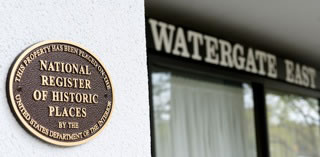Designed by noted Italian architect Luigi Moretti, the Watergate Complex design and construction took place from 1960 to 1971.
The Watergate complex is a group of five buildings in the Foggy Bottom neighborhood of Washington, D.C. The 10-acre site contains two office buildings, three residential cooperative apartment buildings, and a hotel. While the hotel and one office building are connected, today these are independently owned, creating a complex of six separately governed and privately owned buildings.
Conceived as an idea in 1960, the groundbreaking for the 10-acre Watergate complex occurred in 1963. The first shovel went into the ground August 1963 as Riverview Realty, the leasing agent for the Watergate, began to build its rental office. In February 1964, ground was broken for Watergate East, the first of the what was originally 5 buildings. Over time, the buildings were purchased by different companies, resulting in there now being 6 individually owned and operated buildings.At the time, Watergate was the largest privately funded planned urban renewal development (PUD) in the history of Washington, DC. Designed by famed Italian architect Luigi Moretti, and originally developed by the Italian firm Società Generale Immobiliare (SGI), the project was the first to use the new mixed-use rezoning adopted by the District of Columbia in 1958. The Watergate complex was designed to be a "town within a city" to transform the commercial area, making it a home along the Potomac River for businesses and residents alike. There are several theories as to where the name originated.1
The first building, Watergate East, was formally dedicated on October 27, 1965. Residents of Watergate East took full ownership of their cooperative in March 1966. And in 2015, the 50th anniversary of the dedication of the complex and the opening of Building One (now Watergate East).
---------------
Overview of the Complex
Location
The Site
The Vision
The Landscape Vision
The Town within a City
The Name
The Design
Approval Controversies and Construction
The Buildings
Les Champs
Watergate East
Watergate Hotel
2600 Office Building
Watergate West
Watergate South
600 Office Building
Dedication
A Place in History
Società Generale Immobiliare (and the Vatican connection)
The Freeway
Notable Residents
First Burglaries - and other Scandals
Watergate East (WEI), 2500 & 2510 Virginia Avenue NW (residence: opened October 23, 1965)
Watergate Hotel, 2650 Virginia Avenue NW (opened March 30, 1967)
2600 Office Building, 2600 Virginia Avenue NW (opened March 30, 1967. Until 2011, was connected to the Hotel through the respective lobbies.)
Watergate West (WGW), 2700 Virginia Avenue NW (residence: opened Inaugural Day (Nixon) 1969)
Watergate South (WGS), 700 New Hampshire Avenue NW (residence: delivered 1971)
600 Office Building, 600 New Hampshire Avenue NW (delivered 1971)
---------------
The Principal Players
The principal players in the building of the Watergate Complex include the design architectural teams, the development teams, project management, financing, lighting consultant, landscape architect, general contractor, sales and management teams, and engineering firms. Read more.
---------------
The Hotel
Manager (1967-1985): Gabor Olah de Garab
---------------
Historic Materials
Listed here are an index of memorabilia, news & media coverage, oral histories, and 50th anniversary news and notes index.
---------------
Foggy Bottom Neighborhood
Foggy Bottom Photographs
Images depicting the Foggy Bottom neighborhood of Washington, D.C. Drawn from throughout Special Collections, these photographs depict the capital city's historic neighborhood bounded by 17th Street, Rock Creek Parkway, Constitution Avenue, and Pennsylvania Avenue.
Foggy Bottom Association
The Foggy Bottom Association (FBA) was initially incorporated in the District of Columbia on June 19, 1959, as the Foggy Bottom Restoration Association. The present name was formally adopted and ratified May 13, 1965.
The purpose of FBA is to further the civic, cultural, social and economic welfare of the Foggy Bottom/West End community; preserve and enhance the residential character of the community; and promote historic preservation in the area.
The physical area of FBA is primarily in northwest Washington, DC and includes the interior of the area bounded by Rock Creek on the west, the Potomac River on the south; an eastern limit defined by an imaginary line drawn northward from the Potomac River to and along 15th Street to Pennsylvania Avenue to 20th Street, and again northward on 20th Street to N Street; and westward along N Street to Rock Creek. This area mirrors that of Advisory Neighborhood Commission 2A.
Foggy Bottom Alerts
The purpose of this group is to enable the residents of Foggy Bottom to alert one another about issues and proposals that impact the neighborhood.
---------------
National Register of Historic Places & DC Historic Preservation
The District of Columbia Historic Preservation Review Board "held a public hearing on February 24, 2005 on the application for historic designation of the property known as the Watergate or the Watergate Complex (and originally Watergate Towne), 2500, 2600, 2650 and 2700 Virginia Avenue and 600 and 700 New Hampshire Avenue, NW, hereby designates the property a historic landmark to be entered in the District of Columbia Inventory of Historic Sites and requests that the nomination be forwarded to the National Register of Historic Places for listing." [Approval Decision]
On October 12, 2005, the United States Department of the Interior, National Park Service, listed the property in the National Register of Historic Places. [Approval Decision]
Area: Foggy Bottom
Built: 1962-1971
Architects:
Luigi Moretti, consulting architect; Milton Fischer, associate architect; Boris Timchenko, landscape architect
Architectural Style: Modern Movement
Added to NRHP: October 12, 2005
NRHP Reference:
05000540

